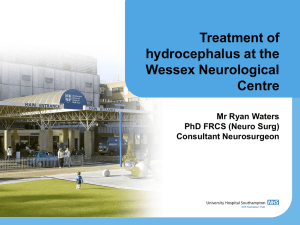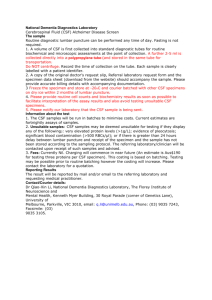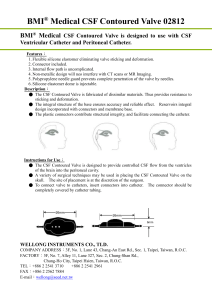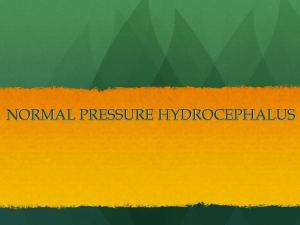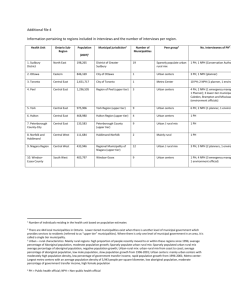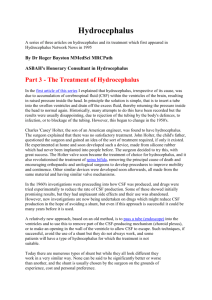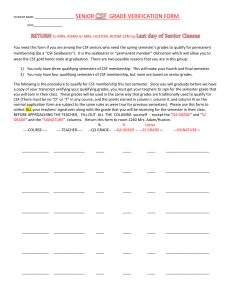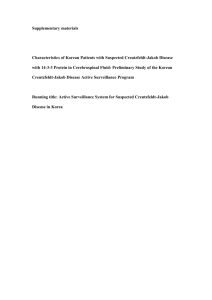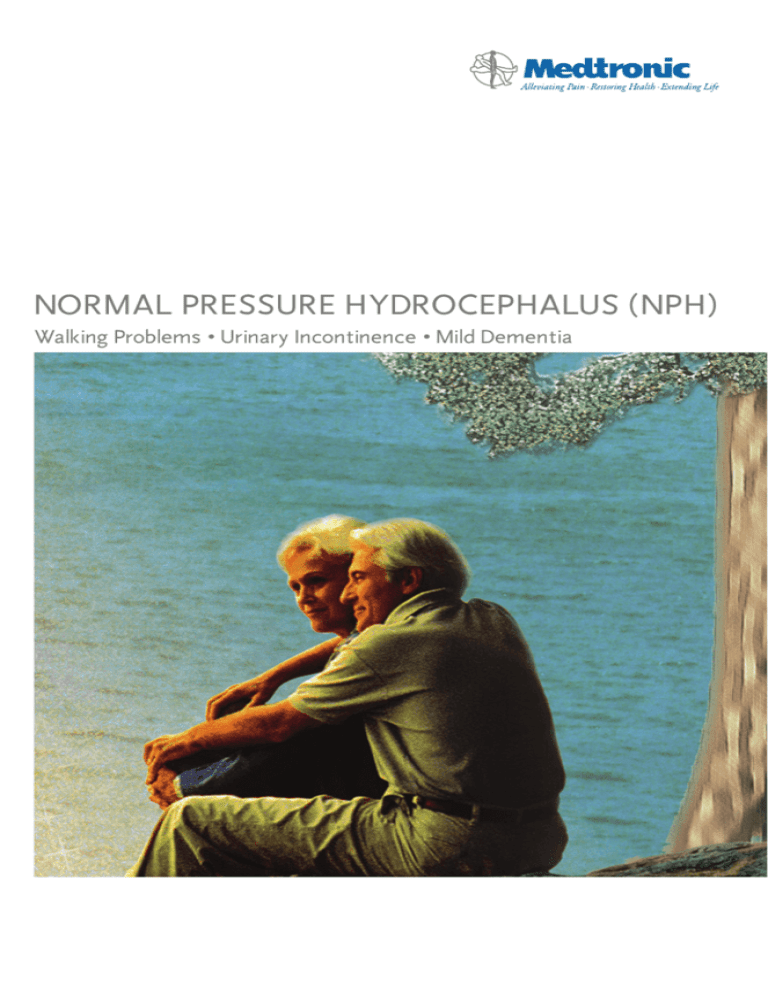
NORMAL PRESSURE HYDROCEPHALUS (NPH)
Walking Problems • Urinary Incontinence • Mild Dementia
Contributing Editor:
Claire S. Houston, R.N., M.S.
ii
T
he purpose of this booklet is to help patients
and their families gain a better understanding of
Normal Pressure Hydrocephalus (NPH) and the
available treatment. Although no ideal treatment
currently exists, numerous advances have contributed to
better patient outcomes over the past few decades. We at
Medtronic are committed to the continued development
of the highest quality medical products used in the treatment of NPH, and are striving to further improve patient
outcomes in the years to come.
Contents
Anatomy and Physiology...............................................................4
Hydrocephalus...................................................................................6
Normal Pressure Hydrocephalus (NPH)...................................8
Signs and Symptoms of NPH.....................................................10
Diagnosing NPH.............................................................................. 13
Treatment......................................................................................... 18
Surgical Procedure........................................................................ 23
Follow-Up Care............................................................................... 25
Complications................................................................................. 27
Glossary............................................................................................. 31
Questions......................................................................................... 35
Anatomy and Physiology
To understand Normal Pressure Hydrocephalus (NPH), a
basic knowledge of the anatomy and physiology of the
brain is helpful.
The brain occupies most of the space inside the skull and
is surrounded by a cushioning layer of cerebrospinal fluid
(CSF). CSF is a clear fluid that surrounds and protects the
brain and spinal cord, acting like a shock absorber, to cushion these critical structures in the event of traumatic injury.
CSF also plays an important role in transporting nutrients
into, and waste products away from, the central nervous
system. This fluid is primarily produced and stored within
the four ventricles, or interconnected cavity-like structures, in the interior of the brain.
The ventricles contain delicate tufted structures known
as choroid plexus. These structures produce CSF at a rate
of approximately 500 ml (about one pint) per day. The
fluid is in continuous circulation through the ventricles and
contains many substances essential for nourishment and
normal function of the nervous system.
CSF flows from each ventricle to the next via small openings before entering the subarachnoid space, which surrounds the brain and spinal cord. CSF then flows over the
surfaces of the brain and spinal cord, where it is eventually
absorbed into the blood stream through one-way, valve-like
structures called pacchionian granulations. CSF is in a continuous process of production, circulation, and absorption.
There is a delicate balance associated with this process,
which keeps the total volume of CSF at a constant level.
Cerebrospinal Fluid (CSF) Circulatory Pathway
Subarachnoid Space
Choroid Plexus
Sagittal Sinus
Lateral Ventricles
Third Ventricle
Arachnoid Space
Aqueduct of Sylvius
Brain
Fourth Ventricle
Skull
Figure 1. Cerebrospinal Fluid (CSF) Circulatory Pathway.
View of the center of the brain with the ventricles and surrounding structures.
The arrows show the major pathway of CSF flow.
Hydrocephalus
In some specific medical conditions, there is an excess of
cerebrospinal fluid (CSF) in the ventricles of the brain. This
is called hydrocephalus, a term derived from two Greek
words: hydro for water and kephale for head.
Hydrocephalus develops when the volume of CSF in the
ventricles is higher than normal. This occurs when the flow
of CSF is blocked within the ventricular system, or when
absorption into the blood stream cannot keep up with the
volume being produced. In other words, there is more CSF
being produced than being absorbed.
Normal vs. Hydrocephalic Ventricles
Figure 2. Normal (left) and enlarged hydrocephalic ventricles (right)
Hydrocephalus can be congenital, which simply means that
the condition existed before birth. It is also possible to have
acquired hydrocephalus, which develops after birth due to a
variety of reasons, such as trauma, brain tumor, scar tissue,
or meningitis. In both, the excessive amount of CSF, can be
caused by a blockage in the ventricular system of the brain
preventing the normal flow of CSF, or as the result of a
problem with CSF absorption. Additionally, there is a condition known as normal pressure hydrocephalus (NPH), which
occurs later in life and is the result of an imbalance in CSF
production and absorption.
Types of Hydrocephalus
Congenital
Acquired
NPH
Condition existed
before birth
Develops after birth as
a result of trauma
or disease
Affects the elderly
Cause not always known
Normal Pressure Hydrocephalus (NPH)
Normal Pressure Hydrocephalus is a condition that affects
individuals typically in their sixties or seventies, and can
rob them of their golden years. It is characterized by the
gradual onset of a triad of symptoms, which most commonly include difficulty walking, urinary incontinence, and
mild dementia. NPH can be difficult to diagnose, since not
all of the symptoms may come about at the same time.
Furthermore, these symptoms are often associated with
other conditions that are common in an aging population,
e.g. Parkinson’s disease, osteoarthritis, and Alzheimer’s disease, to name a few. Left untreated NPH will progress and
significantly impair one’s quality of life.
Coping with the symptoms of NPH can be taxing for both
patients and family members as this affects many aspects
of life, including relationships, social activities, physical
health, and mental health. Patients can become depressed
and sulk, or frustrated and angry, all of which tend to make
the situation worse.
Cause and Incidence
Like other types of hydrocephalus, the defining characteristic of NPH is the enlargement of the ventricles in the
brain. It is not entirely known why this enlargement produces the symptoms associated with NPH, but most evidence seems to suggest a disturbance of the frontal lobe
region of the brain. The expanded ventricles seem to distort the nerve pathways between the brain and the spinal
cord, thus causing the symptoms. The blood flow to the
brain has been seen to decrease in some cases as well.
For over 50% of patients with NPH, the cause of the hydrocephalus cannot be determined. This is called idiopathic
NPH. In the other cases, there is a history of brain hemorrhage (such as from an aneurysm rupture or brain trauma)
or meningitis. However, it is not clear why or how these
conditions lead to NPH.
According to the National Council on Aging (NCOA) the
incidence of NPH is not entirely clear. While some experts
say that approximately 375,000 people have NPH, estimates have ranged from about 200,000 to 750,000 cases.
It is said that about 5% of patients with dementia are likely
to have NPH, which unlike Alzheimer’s disease, can be a
reversible disorder. There is not predilection related to sex
or race.
Normal Pressure Hydrocephalus can
be treated, allowing people to lead
full and productive lives.
Signs and Symptoms of NPH
The syndrome of NPH is usually characterized by a triad of
symptoms: gait disturbances (difficulty walking), urinary
incontinence (poor bladder control), and mild dementia
(forgetfulness or cognitive impairments). These symptoms
may occur at different times, and some may not be present at all. The most common sequence of symptoms is for
the gait disturbance to appear first, then incontinence, and
finally dementia.
The NPH Puzzle
Mild
Dementia
Poor
Bladder
Control
Walking
Difficulties
Figure 3. The NPH triad of symptoms
Gait Disturbance
The pattern of how a person walks is called their gait. With
NPH, gait disturbance is usually the first presenting and
most significant problem. This can be demonstrated by an
unsteady gait with small shuffling steps. Some patients say
they feel like their feet are stuck to the floor or are hard
to pick up, often referred to as “magnetic feet”. There can
10
also be some difficulty negotiating steps and stairs, and
falls are not uncommon. Frequently, patients and families
seek medical attention initially due to a fall.
Urinary Incontinence
In most cases urinary incontinence (impaired bladder control) shows up later in the progression of NPH, and in some
situations, is never a problem. For those who are affected,
symptoms can vary significantly and may include:
Frequency – the need to go to the bathroom or urinate
often.
Urgency – the sudden and compelling need to pass urine,
accompanied by discomfort. If ignored this may produce
incontinence.
Frank Incontinence – the loss of control to hold back urine.
Although this is not life threatening, urinary incontinence
can affect activities of daily living, cause embarrassing social moments, and produce psychological pain.
Mild Dementia
There may be some forgetfulness or short term memory
loss (e.g. not recalling where the keys are or what one had
for breakfast) associated with NPH. Some patients may
lose interest in things they have previously enjoyed (e.g.
playing with grandchildren, playing cards, doing crossword
puzzles). In some instances there can be mood changes,
manifested by withdrawal or having a flat affect, meaning
to act without animation or noticeable excitement. Unlike
other dementias, the dementia caused by NPH can sometimes be reversed or at least stabilized.
11
Because all three of these symptoms can be associated
with the aging process, and the majority of the NPH population is older than 60 years, people often assume that
they must live with these problems. This attitude can lead
to delays in seeking medical attention which further delays the diagnosis and treatment of patients. Since NPH is
a degenerative disease with a variable rate of progress, it
is suggested that the earlier the diagnosis, the better the
chance for successful treatment. However, some who have
experienced symptoms for several years have seen improvement with treatment. Consequently, it makes sense
to have a medical evaluation when NPH is being considered
as a potential diagnosis.
NPH is a difficult-to-diagnose disease,
since the symptoms often mimic other
conditions among the elderly.
12
Diagnosing NPH
A comprehensive examination and careful diagnosis can
provide reassurance to patients and family members,
while establishing a firm foundation for planning treatment
related to NPH or any diagnosis. A detailed history and
complete physical exam are critically important in diagnosing NPH. However, since not all symptoms are required to
consider a diagnosis of NPH, it can be a challenging diagnosis to make.
Once NPH is suspected by a
primary care-giver, additional
tests are usually needed to
confirm the diagnosis and to
determine if shunting may be
an appropriate treatment option. At this point the involvement of a neurosurgeon and/
or neurologist is usually necessary to facilitate the diagnostic
procedures and interpretation
of their results.
Diagnostic Procedures
There are several diagnostic procedures to both confirm
the diagnosis of NPH and to rule out other conditions.
These may include Brain Imaging, Neuropsychological Testing, and CSF Lumbar Drainage.
13
Brain Imaging
Imaging exams are often used to determine if a patient’s
ventricle are enlarged.
Computerized Axial Tomography (CT or
CAT) Scan is a commonly performed
imaging procedure that is noninvasive and
well-tolerated. It produces cross-sectional images that allow doctors to look
at the inside of many different parts of
the body and/or brain. CT uses x-rays to
produce these images.
Magnetic Resonance Imaging (MRI) is
often used to further evaluate an abnormality seen on a CT scan. This is an imaging technique that uses strong magnetic
radio waves to produce high quality images of the inside of the human body or
brain. It is widely used when a diagnosis
of NPH is being considered as it provides
14
Figure 4. CT scan of a
hydrocephalic brain
Figure 5. MRI of a
hydrocephalic brain
important detail of the ventricular system and can help to
rule out other disorders, e.g. subdural hematoma, tumor,
infection, or a structural abnormality.
Neuropsychological Testing
Neuropsychological testing is the
most accurate means of determining and documenting cognitive
strengths and problems. This testing is typically part of the standard medical workup for NPH and
it involves answering questions,
performing tasks and following
instructions. The tests are given
by a trained professional who will
also be evaluating the patient’s
mood and any level of anxiety.
Even though many NPH patients
have no obvious clinical evidence of dementia they may be
at an impaired level with sensitive testing. These tests are
useful to quantify subtle pre-operative and post-operative
changes and improvements in mental status.
Neuropsychological Testing Areas
• Attention
• Reaction Time
• Memory
• Reasoning
• Language
• Emotional State
15
Lumbar CSF Drainage
These exams are used to predict the likelihood of a positive
response by the patient to a shunting procedure. Though
there is no way to accurately predict how an individual
patient will respond, many doctors find the following tests
helpful for their diagnosing.
Lumbar Puncture or Spinal Tap is an invasive diagnostic
test that allows CSF to be removed for examination and the
pressure of the spinal
column to be measured. Typically about
40 – 50 ml (about 3
tablespoons) of CSF
is removed to see if
any of the symptoms
of NPH are relieved.
Generally, there is a
Figure 6. Lumbar Puncture or Spinal Tap
response to the gait
disturbance within about 6 hours, so the patient should
expect to be re-examined the same day. Improvement of
symptoms following a lumbar puncture is potentially indicative of a positive response to shunting.
16
External Lumbar Drainage is an option if a patient does not
respond to a simple lumbar puncture. There may be a need
for more CSF to be
removed or more time
may be required to
demonstrate a response. This procedure
requires hospitalization
for 3 to 5 days, so that
CSF can be drained
and regular assessFigure 7. External Lumbar Drainage
ments of the patient’s
symptoms can be made, in an effort to determine if there
will likely be a response to a surgical shunting procedure.
CSF Outflow Resistance is a more involved test that determines the capacity of the body to absorb excess CSF. The
test involves a lumbar puncture, infusion of artificial spinal
fluid, and specialized laboratory equipment that determines
the body’s absorption capacity – sometimes called “outflow
resistance”. If the outflow resistance is abnormally high,
there is a good chance that the patient will improve with
shunt surgery.
Although currently there is no strict algorithm,
definitive test, or gold standard for predicting with
certainty the existence of NPH, improvement has
been recognized in patients with varying duration and significance of symptoms. Consequently a
medical evaluation of all potential NPH patients is
worthwhile.
17
Treatment
The only effective treatment of NPH involves the surgical
implantation of a shunt system. A shunt is a device that
reroutes CSF from the nervous system to another area of
the body. In order to divert CSF, the surgeon will insert a
device, made of silicone and polypropylene plastic, under
the skin. There are no parts on the outside of the body.
The shunt is an implantable device designed to drain CSF
away from the nervous system, allowing the enlarged
ventricles to decrease in size in an effort to relieve the
symptoms of NPH. The shunt system consists of two
small tubes, called catheters, and a one-way valve, which
regulates the rate of CSF drainage. As the pressure of
CSF inside the brain or spine increases, the one-way valve
opens and the excessive fluid drains to the peritoneal cavity
(abdomen). This is called a ventriculoperitoneal or VP shunt
(Figure 8). Occasionally CSF is shunted to a chamber of the
heart called the right atrium (a ventriculoatrial or VA shunt)
or from the lumbar spine (lower back) to the abdominal
cavity (lumboperitoneal or LP shunt, Figure 9).
The two main types of shunt valves available are fixed
pressure valves and adjustable pressure valves. Fixed pressure valves regulate the flow rate of the CSF based on a
predetermined pressure setting. Adjustable valves regulate
the flow of CSF based on an adjustable pressure setting.
By using custom magnetic tools, the doctor can non-invasively change the pressure setting of a patient’s implanted
adjustable valve during an office visit, without the need for
another surgical procedure.
18
Both of these types of valves can include overdrainage protection in the form of a siphon control device. The purpose
of a siphon control device is to minimize excessive drainage
due to gravity, which can cause more CSF to drain when
the patient is in the upright position.
Valve
Ventricular
Catheter
Ventricles
Cardiac/Peritonal
Catheter
Peritoneal
Cavity
Figure 8. Ventriculoperitoneal (VP) or
ventriculoatrial (VA) shunt placement
Figure 9. Lumboperitoneal (LP) shunt placement
19
Medtronic Technologies
Figure 10. Delta® valves (fixed pressure
valves with siphon control devices)
Figure 12. Strata tools (for adjusting the
pressure setting of Strata valves)
20
Figure 11. Strata® II valves (adjustable pressure
valves with siphon control devices)
Figure 13. StrataVarius™ (for adjusting the
pressure setting of Strata valves)
Silicone Dome
Proximal Occluder
Integral Inlet
Connector
Radiopaque
Marker
Reservoir
Firm Polypropylene
Plastic Base
Radiopaque
Performance/Flow Direction
Indicators
Distal Occluder
Delta
Chamber
Integral Outlet
Connector
Silicone
Membrane
Valve
Figure 14. Cutaway of a Delta® valve
Silicone Dome
Proximal Occluder
Integral Inlet
Connector
Radiopaque Valve
to Catheter
Indicator
Reservoir
Radiopaque Flow
Direction Indicator
Distal Occluder
Delta Chamber
Integral Outlet
Connector
Firm Plastic Base Adjustable Valve
Mechanism
Radiopaque Valve
to Catheter
Indicator
Figure 15. Cutaway of a Strata® II valve
21
Precaution
Since adjustable valves include magnets, special precautions must be observed around magnetic sources. If a
device is known to contain a magnet, keep it away from
the immediate valve location, i.e. the skin next to the valve.
For patients that are undergoing an MRI procedure, it will
be necessary for the doctor to check the valve pressure
setting afterwards and readjust the valve if necessary.
Ask your doctor for specifics on the sensitivity to common environmental levels of electromagnetic radiation for
particular valves.
The pressure setting of an implanted
adjustable valve can be non-invasively
changed by a doctor
22
Surgical Procedure
Each type of shunt has advantages and disadvantages.
Because each patient is unique, the neurosurgeon will decide which type of shunt is used, based on their own experience and the individual needs of the patient.
The surgical procedure is carried out under general anesthesia with sterile conditions in the operating room.
Although the operation is relatively short (often the surgery can be done in under an hour), careful preparation for
the surgery adds extra time. In order to help prevent infection, some of the hair may need to be shaved. The head and
body are washed with a special antibacterial soap. Sterile
linen is used to cover the patient and to maintain the sterile
environment throughout the surgical procedure.
Ventriculoperitoneal (VP) Shunt
For VP shunts, a few small incisions (cuts) are required to
do the procedure (See Figure 8). One incision is made in
the scalp (the skin covering the head). A small hole is then
made in the skull and a tiny opening is made in the dura, a
protective covering of the brain. These openings are made
to accommodate the ventricular (proximal) catheter being
placed into the lateral ventricle. The neurosurgeon usually
places the shunt valve above or behind one ear and attaches it to the two catheters. The distal catheter is then
tunneled under the skin to the abdomen where an additional small incision, about 0.5” is made. Finally, the end
of the catheter is carefully placed in the peritoneal cavity.
Following the operation, small sterile bandages are applied
to each incision.
23
Lumboperitoneal (LP) Shunt
For lumboperitoneal shunts, an incision is made near the
base of the spine, and a small catheter is inserted into the
subarachnoid space of the lower spine (See Figure 9). This
is the same location where a lumbar puncture takes place.
The catheter is attached to the valve, which is usually
placed around the hip bone, and then the distal catheter is
tunneled under the skin to the abdomen, where it is inserted in the peritoneal cavity.
Post-Operation
Immediately after surgery, the patient will go to the postanesthesia care unit. Patients generally remain there for
about an hour for close observation and then go to their
assigned hospital room. The length of hospitalization varies
from patient to patient. Most patients leave the hospital
within two to seven days, depending on their clinical progress. Although this is the usual procedure when a shunt is
placed, each patient may have a slightly different experience based on their neurosurgeon, the hospital protocol,
and the need to individualize patient care.
Regular visits to your neurosurgeon
or neurologist will be necessary.
24
Follow-Up Care
Many patients with hydrocephalus can look forward
to a normal future. However, because this condition
is “on-going,” patients do
require long-term, follow-up
care by a physician knowledgeable in the diagnosis
and treatment of NPH. Having medical check-ups at intervals recommended by the neurosurgeon or neurologist will
be necessary. Physical and occupational therapy are also
worthwhile methods to speed recovery and further enhance one’s health post-operatively.
The patient, or his/her family, must assume a share of
the responsibility for follow-up care. The physician will
also keep a watchful eye on the patient and pick up subtle
changes and symptoms that may indicate a complication.
The symptoms associated with NPH (walking difficulties,
poor bladder control, mild dementia) may improve quickly
or may take weeks to months to improve. In some patients,
little or no improvement is a possible outcome. Cognitive
impairments are the least likely symptom to be relieved.
The rate of success for treating NPH is quite variable, and
neurosurgeons do not agree on the factors that will lead to
a successful outcome. For those patients that do improve,
changes usually occur in the first few weeks; however, a
late response to treatment is also possible.
25
Emotional Support
The physical aspect of NPH is just one part of dealing with
this condition. Emotional factors must also be considered,
for the patient as well as the family. Although the surgical
procedure is likely to control NPH, those involved may be
upset, fearful, depressed, angry, or frustrated.
Expressing your feelings to
your physician will help them
to provide the best professional guidance for you. Many
patients can handle their
emotions with the help of
relatives and friends, but for
others, professional help may
be necessary. Healthcare
professionals are interested
in the total well-being of their
patients. The plan is always
to do what is best for the
patient and family in an
effort to accomplish this goal.
However, patients and family members should take an
active role in their medical care and be a partner with the
physicians. They should actively participate in the communication process, so there is a clear understanding of what
is happening and what is needed.
26
Complications
The potential complications associated with shunt surgery
must be viewed not only as those associated with the actual surgical procedure but also those that may occur days,
weeks, or even years later. Unlike most surgical procedures,
where the risks are highest during the operation itself,
most of the common problems associated with shunting
can and do occur at a later time.
The major complications of shunting are obstruction,
infection, overdrainage of CSF, and mechanical breakage. Patients and families should be alert to the signs and
symptoms of shunt complications and recognize that shunt
revisions may be necessary to replace a component that is
not working.
Symptoms of Shunt Complications
• Loss of coordination or
balance
• Redness or swelling along the
shunt tract
• Personality change or
confusion
• Headache
• Loss of bladder control
• Difficulty in waking up or
staying awake
• Fever
• Seizures
• Paralysis
27
Shunt Obstruction
A common complication of shunting is obstruction of the
system. Obstruction may occur at any point along the
shunt system. In the brain, the small openings of the ventricular catheter may become plugged or blocked with
choroid plexus, the tissue that produces CSF. This may occur due to a significant reduction in size of the ventricular
cavity (slit ventricle) due to over-drainage of CSF.
The peritoneal catheter may become surrounded by loops
of bowel, other structures, or by scar tissue, which can
block the outlet of CSF. Shunts placed in the right atrium
of the heart may be obstructed by the clotting of blood
around the end of the catheter tube. The shunt may also
become obstructed if the components become separated.
If there is a shunt obstruction within the shunt system,
patients with NPH typically recognized that there is a problem because the original symptoms reoccur.
Infection
Another common complication of CSF shunting is infection. This risk is present in all surgical operations — particularly when an implant, such as a shunt system, is required.
If there is any unusual redness or swelling at the site of
the wounds or along the length of the shunt system (the
shunt track), infection should be suspected. These changes
should be called to the attention of the neurosurgeon immediately. If not treated, infection can lead to the wound(s)
opening up or, more seriously, to systemic infection with
chills and a high fever. Infection usually requires removal of
the shunt system, however, in some situations the infec28
tion may be controlled with intensive antibiotic therapy,
without the removal of the shunt.
Since the shunt system is an implant or a “foreign body,”
a patient may develop an allergic or inflammatory reaction
to it at any time. Although this is uncommon it is important
to report any inflammation or open sores over any part of
the implanted system to the attention of the neurosurgeon
immediately.
CSF Overdrainage
Overdrainage is generally caused when too much CSF
drains out of the ventricles too quickly. Overdrainage may
produce a variety of signs and symptoms. Patients generally will experience a headache that is worse when upright
and reduced by lying down.
Other complications can also occur in the days and months
following the surgery. The most serious complication is a
subdural hematoma (blood clot) on the surface of the brain.
This can result from draining too much fluid out of the brain
too quickly, causing the brain tissue to shift away from the
skull and blood vessels on the surface of the brain to tear
and bleed.
A shunt-related hematoma commonly occurs as a result
of a fall, even if there are no apparent injuries. Symptoms
associated with a subdural hematoma vary from headaches,
paralysis, and may be as severe as coma or death. The risk
of an NPH shunt patient developing a subdural hematoma is
approximately 5 to 10%.
29
Mechanical Breakage
Shunt systems include several components linked in sequence, providing an open pathway for CSF to flow from
a ventricle in the brain or the subarachnoid space of the
spine, to the peritoneal cavity or right atrium of the heart.
Any disconnection between the elements of the shunt system may result in improper drainage of CSF.
It is important for patients with NPH and their
families to be aware of the potential complications
that can occur following shunt surgery. It is essential for patients, family members, and caregivers to
have knowledge of the signs and symptoms of these
complications and the necessity for emergency
medical evaluation in these instances.
30
Glossary
Abdominal Cavity: The area of the body between the chest and
pelvis containing the liver, intestines, kidneys and other organs.
(Synonymous with the peritoneal cavity)
Antibiotic: Any substance (such as Penicillin) which destroys or
inhibits the growth of bacteria
Arachnoid: A thin membrane, internal to the dura
Atrium: One of the two upper chambers of the heart
Cerebrospinal Fluid (CSF): The fluid filling the ventricles of the
brain and surrounding the brain and spinal cord
CAT or CT scan: Abbreviation for computerized axial tomography, a special x-ray technique which outlines the ventricles and
other structures of the brain in cross section
Choroid Plexus: Delicate structures in the ventricles of the brain
that produce CSF
Coma: A state in which the patient doesn’t respond to stimulation
Congenital: A condition present since birth
CSF: Cerebrospinal fluid
Diagnosis: Determination of a patient’s problem
Distal Catheter: Shunt catheter that is farthest from the ventricles, usually in the peritoneal cavity
Dura: The outer most, fibrous membrane that surrounds the brain
and spinal cord (also dura mater)
Dementia: Refers to a group of symptoms involving progressive
impairment of brain function. This may include forgetfulness,
apathy, and/or deterioration in ones level of functioning on a
day-to-day basis
31
Gait Disturbance: An unusual and uncontrollable problem with
walking, which may include weakness of the legs, unsteady
walking, and small shuffling steps
Foreign Body: An object, such as an implant, introduced into a living body from the outside
Hydrocephalus: Excessive build-up of CSF in the ventricles of the
brain, causing compression on other surrounding structures of
the brain
Hydrocephalus, Acquired: Hydrocephalus developed after birth
Hydrocephalus, Communicating: Hydrocephalus in which there
is no obstruction between ventricles and subarachnoid space
Hydrocephalus, Congenital: Hydrocephalus existing before or at
birth
Hydrocephalus, Non-Communicating or Obstructive: Hydrocephalus in which there is obstruction of CSF flow between
ventricles
Hydrocephalus, Normal Pressure: A syndrome characterized by
enlargement of the ventricles along with a triad of symptoms
that include gait disturbance, dementia, and impaired bladder
control
Incontinence: The inability to control the passage of urine. This can
range from occasional leakage of urine, to a complete inability
to hold any urine
Intracranial Pressure (ICP): The pressure within the skull
Isotope: A radioactive material used for determining spinal fluid flow
and shunt function
Lumbar Puncture: A procedure to obtain a specimen of CSF by
positioning a small needle or catheter into the subarachnoid
space, at the level of the lumbar spine, in order to withdraw CSF
for appropriate testing. Also known as a Spinal Tap
32
Lumbar Spine: The area of the spine in the small of the back
Meninges: The coverings of the brain and spinal cord made up of
the dura mater, arachnoid, and pia mater
Meningitis: Inflammation or infection of the meninges
MRI: Abbreviation for Magnetic Resonance Imaging. By means of
magnetic energy, images are taken, showing the ventricles and
other structures within the brain
Neurological: Pertaining to the nervous system (including the brain
and spinal cord)
Normal Pressure Hydrocephalus: A syndrome characterized by
enlargement of the ventricles within the brain along with a triad
of symptoms that may include gait disturbance, dementia, and
impaired bladder control
Peritoneum: Lining of the abdominal cavity
Peritoneal Cavity: The abdominal cavity
Pia mater: A very delicate, highly vascular, layer of tissue that is
adherent to the brain and spinal cord, following all the contours
Polypropylene: Plastic used in the manufacture of shunt systems
Proximal Catheter: Shunt catheter in the ventricle
Shunt (noun): A system of tubing used to drain CSF from the ventricles or subarachnoid space into another area of the body
Shunt (verb): Surgical procedure during which a shunt system is
implanted
Silicone: A polymer characterized by inertness in the body tissues
and used in the manufacture of shunt systems and other medical devices
Skull: The boney structure that surrounds and protects the brain
Slit Ventricle: Excessive narrowing of the lateral ventricle due to
over-drainage of CSF
33
Spinal Cord: An elongated structure that is a component of the
central nervous system. It is the main pathway for information
connecting the brain and peripheral nervous system. The human spinal cord is protected by the bony spinal column.
Stuporous: A semi-conscious condition, in which the patient is very
sleepy
Subarachnoid Space: A place where cerebrospinal fluid circulates
Subdural Hematoma: A collection of blood between the dura,
outer covering of the brain, and the surface of the brain
Urinary Incontinence: The inability to control the passage of
urine. This can range from occasional leakage of urine, to a
complete inability to hold urine
Valve: A one-way device used to control drainage of CSF from the
ventricles of the brain or the lumbar area of the spine
Ventricles: The four cavities (two lateral, one third, and one fourth)
lying within the brain
34
Questions
For more information on NPH and the available treatments,
talk to your physician, neurosurgeon, or neurologist.
You can also visit Medtronic’s website at
www.medtronic.com
or the Hydrocephalus Association at
www.hydroassoc.org
35
NPH cannot be “cured,” but it
can be effectively treated,
allowing the patient to lead a
full and productive life.
This therapy is not for everyone. Please consult your physician.
A prescription is required. For more information, please contact us
at 800-510-6735 or refer to our website at www.medtronic.com.
Medtronic Neurologic Technologies
125 Cremona Drive • Goleta, California 93117-5500 USA
(800) 468-9710 USA/Canada
(901) 344-0645 International
(800) 468-9713 FAX
(901) 396-2698 FAX International
For more information, please contact your neurosurgeon or neurologist,
or refer to www.medtronic.com.
Caution: Federal (USA) law restricts these devices to sale by or on the order of a physician.
Refer to product package insert for instructions, warnings, precautions and complications.
LIT59366 Rev. B 9.2007
©Medtronic, Inc. 2007
All Rights Reserved
Printed in USA
36
Strata® and Delta® are registered trademarks of Medtronic, Inc.
StrataVarius™ is a trademark of Medtronic, Inc.

